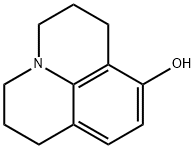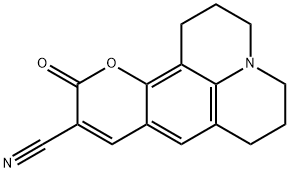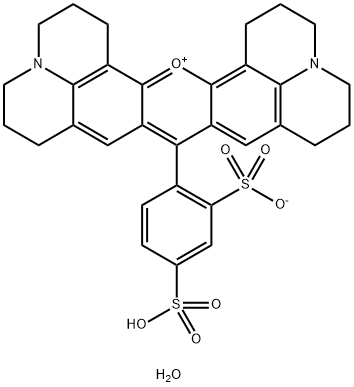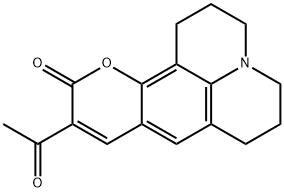8-HYDROXYJULOLIDINE
Synonym(s):2,3,6,7-Tetrahydro-1H,5H-benzo[ij]quinolizin-8-ol;2,3,6,7-Tetrahydro-1H,5H-benzo[i,j]-quinolizin-8-ol
- CAS NO.:41175-50-2
- Empirical Formula: C12H15NO
- Molecular Weight: 189.25
- MDL number: MFCD00006918
- EINECS: 255-247-9
- SAFETY DATA SHEET (SDS)
- Update Date: 2025-07-24 18:13:47

What is 8-HYDROXYJULOLIDINE?
Chemical properties
pink to beige or brown fine crystalline powder
The Uses of 8-HYDROXYJULOLIDINE
8-Hydroxyjulolidine is used as an intermediate in the preparation of aminocoumarins via microwave-accelerated Pechmann reaction. It is also employed as a starting material for coumarin C-ribosides.
The Uses of 8-HYDROXYJULOLIDINE
8-Hydroxyjulolidine has been used in the electrochemical switching fluorescence study.
What are the applications of Application
8-Hydroxyjulolidine is an intermediate and starting material for various coumarin syntheses
General Description
The carboxaldehyde derivative of 8-hydroxyjulolidine is useful as a chromophore in fluorescence chemosensor and chemosensors.
Properties of 8-HYDROXYJULOLIDINE
| Melting point: | 132-134 °C(lit.) |
| Boiling point: | 374.4±41.0 °C(Predicted) |
| Density | 1.22±0.1 g/cm3(Predicted) |
| storage temp. | room temp |
| solubility | Chloroform (Slightly), Methanol (Slightly) |
| form | Solid |
| pka | 11.25±0.20(Predicted) |
| color | White to Pink |
| Water Solubility | Soluble in water (partly), ethanol, chloroform, methanol, and acetone. |
| BRN | 1530423 |
| CAS DataBase Reference | 41175-50-2(CAS DataBase Reference) |
| EPA Substance Registry System | 1H,5H-Benzo[ij]quinolizin-8-ol, 2,3,6,7-tetrahydro- (41175-50-2) |
Safety information for 8-HYDROXYJULOLIDINE
| Signal word | Warning |
| Pictogram(s) |
 Exclamation Mark Irritant GHS07 |
| GHS Hazard Statements |
H315:Skin corrosion/irritation H319:Serious eye damage/eye irritation H335:Specific target organ toxicity, single exposure;Respiratory tract irritation |
| Precautionary Statement Codes |
P261:Avoid breathing dust/fume/gas/mist/vapours/spray. P264:Wash hands thoroughly after handling. P264:Wash skin thouroughly after handling. P271:Use only outdoors or in a well-ventilated area. P280:Wear protective gloves/protective clothing/eye protection/face protection. P302+P352:IF ON SKIN: wash with plenty of soap and water. P305+P351+P338:IF IN EYES: Rinse cautiously with water for several minutes. Remove contact lenses, if present and easy to do. Continuerinsing. |
Computed Descriptors for 8-HYDROXYJULOLIDINE
New Products
Indole Methyl Resin tert-butyl 9-methoxy-3-azaspiro[5.5]undecane-3-carboxylate Boc-His(Boc)-OH 2-CTC Resin 4-Chloro-7-tosy1-7Hpyrrolo[2,3-d]pyrimidine 5,7-Dibromo-1H-indole 2,5-dichloro-N-hydroxy-4,6-dimethylpyridine-3-carboximidamide 2,2-Dimethoxy-7-azaspiro[3.5]nonane hydrochloride 4-chloromethyl-5-methyl-1,3-dioxol-2-one (DMDO-Cl) R-2-BENZYLOXY PROPIONIC ACID 1,1’-CARBONYLDIIMIDAZOLE 1,1’-CARBONYLDI (1,2-4 TRIAZOLE) N-METHYL INDAZOLE-3-CARBOXYLIC ACID 4-((2-hydroxyethyl)thio)benzoic acid 1-(TERT-BUTOXYCARBONYL)-2-PYRROLIDINONE Methyl 6-methylnicotinate 3-Pyridineacrylic acid tert-Butyl carbazate TETRAHYDRO-2H-PYRAN-3-OL 2-((4-morpholinophenylamino) (methylthio) methylene) malononitrile 3-(4-morpholinophenylamino)-5-amino-1H-pyrazole-4-carbonitrile 2,4-dihydroxybenzaldehyde 1,3-Diethyl-1,3-Diphenylurea Methyl 2-methylquinoline-6-carboxylateRelated products of tetrahydrofuran








You may like
-
 8-Hydroxyjulolidine CAS 41175-50-2View Details
8-Hydroxyjulolidine CAS 41175-50-2View Details
41175-50-2 -
 8-Hydroxyjulolidine CAS 41175-50-2View Details
8-Hydroxyjulolidine CAS 41175-50-2View Details
41175-50-2 -
 8-hydroxyjulolidine CAS Number: 41175-50-2View Details
8-hydroxyjulolidine CAS Number: 41175-50-2View Details
41175-50-2 -
 Pyridine 99.5% HPLC /UV SpectroscopyView Details
Pyridine 99.5% HPLC /UV SpectroscopyView Details
110-86-1 -
 Piperazine Spot supply, best priceView Details
Piperazine Spot supply, best priceView Details
110-85-0 -
 Dibutyl PhthalateView Details
Dibutyl PhthalateView Details
84-74-2 -
 Imidazole Spot supply, competitive priceView Details
Imidazole Spot supply, competitive priceView Details
288-32-4 -
 Thiourea 99% ARView Details
Thiourea 99% ARView Details
62-56-6
Statement: All products displayed on this website are only used for non medical purposes such as industrial applications or scientific research, and cannot be used for clinical diagnosis or treatment of humans or animals. They are not medicinal or edible.
